Effective Communication in Nursing: A Patient-Centered Approach
VerifiedAdded on 2022/08/30
|6
|1469
|20
Report
AI Summary
This report delves into the critical role of professional communication in nursing, emphasizing its impact on patient outcomes. It explores the importance of verbal and non-verbal communication skills in establishing therapeutic relationships, gathering crucial patient information, and ensuring patient safety. The report highlights the significance of person-centered care, advocating for a holistic approach that respects patient personhood and fosters trust. Furthermore, it discusses the benefits of effective documentation, particularly through electronic health records (EHRs), for accessing accurate patient information and improving healthcare quality. The analysis includes practical applications for patient scenarios, such as Mr. George Pham, demonstrating how skilled communication and patient-centered care can lead to positive health outcomes. The report underscores the need for healthcare professionals to be aware of the vulnerabilities of specific patient groups and to tailor their communication accordingly, ultimately enhancing patient satisfaction and well-being.
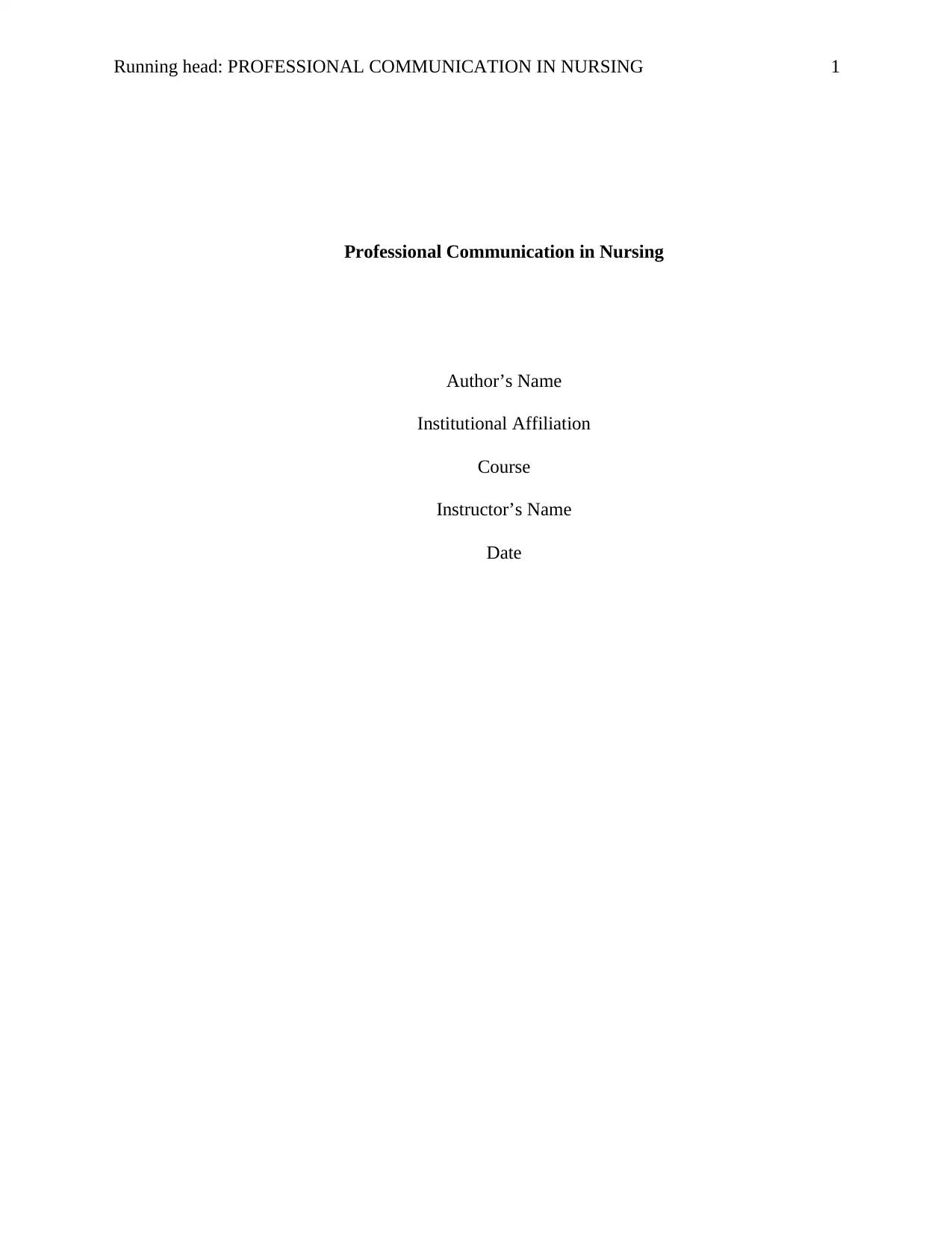
Running head: PROFESSIONAL COMMUNICATION IN NURSING 1
Professional Communication in Nursing
Author’s Name
Institutional Affiliation
Course
Instructor’s Name
Date
Professional Communication in Nursing
Author’s Name
Institutional Affiliation
Course
Instructor’s Name
Date
Paraphrase This Document
Need a fresh take? Get an instant paraphrase of this document with our AI Paraphraser
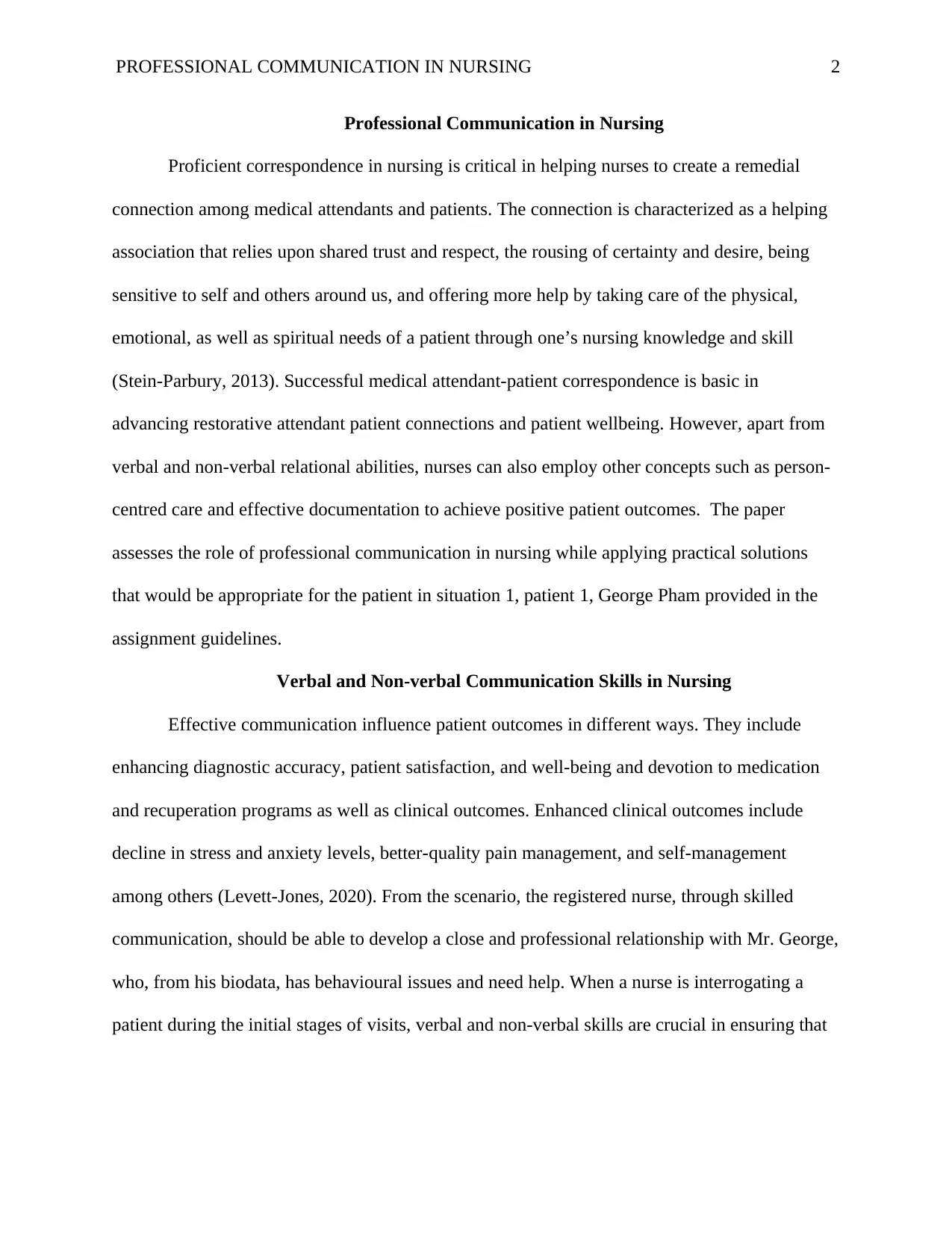
PROFESSIONAL COMMUNICATION IN NURSING 2
Professional Communication in Nursing
Proficient correspondence in nursing is critical in helping nurses to create a remedial
connection among medical attendants and patients. The connection is characterized as a helping
association that relies upon shared trust and respect, the rousing of certainty and desire, being
sensitive to self and others around us, and offering more help by taking care of the physical,
emotional, as well as spiritual needs of a patient through one’s nursing knowledge and skill
(Stein-Parbury, 2013). Successful medical attendant-patient correspondence is basic in
advancing restorative attendant patient connections and patient wellbeing. However, apart from
verbal and non-verbal relational abilities, nurses can also employ other concepts such as person-
centred care and effective documentation to achieve positive patient outcomes. The paper
assesses the role of professional communication in nursing while applying practical solutions
that would be appropriate for the patient in situation 1, patient 1, George Pham provided in the
assignment guidelines.
Verbal and Non-verbal Communication Skills in Nursing
Effective communication influence patient outcomes in different ways. They include
enhancing diagnostic accuracy, patient satisfaction, and well-being and devotion to medication
and recuperation programs as well as clinical outcomes. Enhanced clinical outcomes include
decline in stress and anxiety levels, better-quality pain management, and self-management
among others (Levett-Jones, 2020). From the scenario, the registered nurse, through skilled
communication, should be able to develop a close and professional relationship with Mr. George,
who, from his biodata, has behavioural issues and need help. When a nurse is interrogating a
patient during the initial stages of visits, verbal and non-verbal skills are crucial in ensuring that
Professional Communication in Nursing
Proficient correspondence in nursing is critical in helping nurses to create a remedial
connection among medical attendants and patients. The connection is characterized as a helping
association that relies upon shared trust and respect, the rousing of certainty and desire, being
sensitive to self and others around us, and offering more help by taking care of the physical,
emotional, as well as spiritual needs of a patient through one’s nursing knowledge and skill
(Stein-Parbury, 2013). Successful medical attendant-patient correspondence is basic in
advancing restorative attendant patient connections and patient wellbeing. However, apart from
verbal and non-verbal relational abilities, nurses can also employ other concepts such as person-
centred care and effective documentation to achieve positive patient outcomes. The paper
assesses the role of professional communication in nursing while applying practical solutions
that would be appropriate for the patient in situation 1, patient 1, George Pham provided in the
assignment guidelines.
Verbal and Non-verbal Communication Skills in Nursing
Effective communication influence patient outcomes in different ways. They include
enhancing diagnostic accuracy, patient satisfaction, and well-being and devotion to medication
and recuperation programs as well as clinical outcomes. Enhanced clinical outcomes include
decline in stress and anxiety levels, better-quality pain management, and self-management
among others (Levett-Jones, 2020). From the scenario, the registered nurse, through skilled
communication, should be able to develop a close and professional relationship with Mr. George,
who, from his biodata, has behavioural issues and need help. When a nurse is interrogating a
patient during the initial stages of visits, verbal and non-verbal skills are crucial in ensuring that
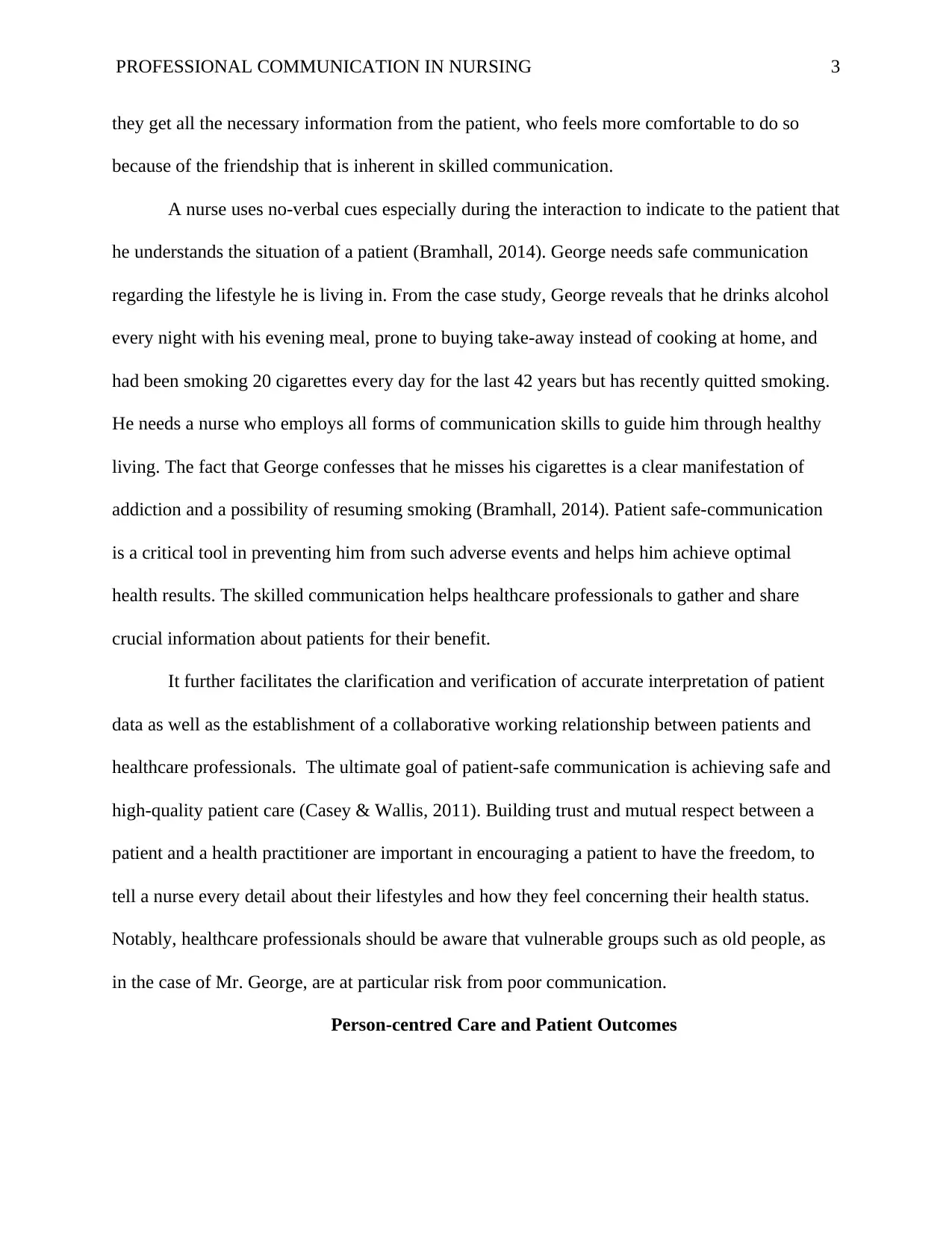
PROFESSIONAL COMMUNICATION IN NURSING 3
they get all the necessary information from the patient, who feels more comfortable to do so
because of the friendship that is inherent in skilled communication.
A nurse uses no-verbal cues especially during the interaction to indicate to the patient that
he understands the situation of a patient (Bramhall, 2014). George needs safe communication
regarding the lifestyle he is living in. From the case study, George reveals that he drinks alcohol
every night with his evening meal, prone to buying take-away instead of cooking at home, and
had been smoking 20 cigarettes every day for the last 42 years but has recently quitted smoking.
He needs a nurse who employs all forms of communication skills to guide him through healthy
living. The fact that George confesses that he misses his cigarettes is a clear manifestation of
addiction and a possibility of resuming smoking (Bramhall, 2014). Patient safe-communication
is a critical tool in preventing him from such adverse events and helps him achieve optimal
health results. The skilled communication helps healthcare professionals to gather and share
crucial information about patients for their benefit.
It further facilitates the clarification and verification of accurate interpretation of patient
data as well as the establishment of a collaborative working relationship between patients and
healthcare professionals. The ultimate goal of patient-safe communication is achieving safe and
high-quality patient care (Casey & Wallis, 2011). Building trust and mutual respect between a
patient and a health practitioner are important in encouraging a patient to have the freedom, to
tell a nurse every detail about their lifestyles and how they feel concerning their health status.
Notably, healthcare professionals should be aware that vulnerable groups such as old people, as
in the case of Mr. George, are at particular risk from poor communication.
Person-centred Care and Patient Outcomes
they get all the necessary information from the patient, who feels more comfortable to do so
because of the friendship that is inherent in skilled communication.
A nurse uses no-verbal cues especially during the interaction to indicate to the patient that
he understands the situation of a patient (Bramhall, 2014). George needs safe communication
regarding the lifestyle he is living in. From the case study, George reveals that he drinks alcohol
every night with his evening meal, prone to buying take-away instead of cooking at home, and
had been smoking 20 cigarettes every day for the last 42 years but has recently quitted smoking.
He needs a nurse who employs all forms of communication skills to guide him through healthy
living. The fact that George confesses that he misses his cigarettes is a clear manifestation of
addiction and a possibility of resuming smoking (Bramhall, 2014). Patient safe-communication
is a critical tool in preventing him from such adverse events and helps him achieve optimal
health results. The skilled communication helps healthcare professionals to gather and share
crucial information about patients for their benefit.
It further facilitates the clarification and verification of accurate interpretation of patient
data as well as the establishment of a collaborative working relationship between patients and
healthcare professionals. The ultimate goal of patient-safe communication is achieving safe and
high-quality patient care (Casey & Wallis, 2011). Building trust and mutual respect between a
patient and a health practitioner are important in encouraging a patient to have the freedom, to
tell a nurse every detail about their lifestyles and how they feel concerning their health status.
Notably, healthcare professionals should be aware that vulnerable groups such as old people, as
in the case of Mr. George, are at particular risk from poor communication.
Person-centred Care and Patient Outcomes
⊘ This is a preview!⊘
Do you want full access?
Subscribe today to unlock all pages.

Trusted by 1+ million students worldwide
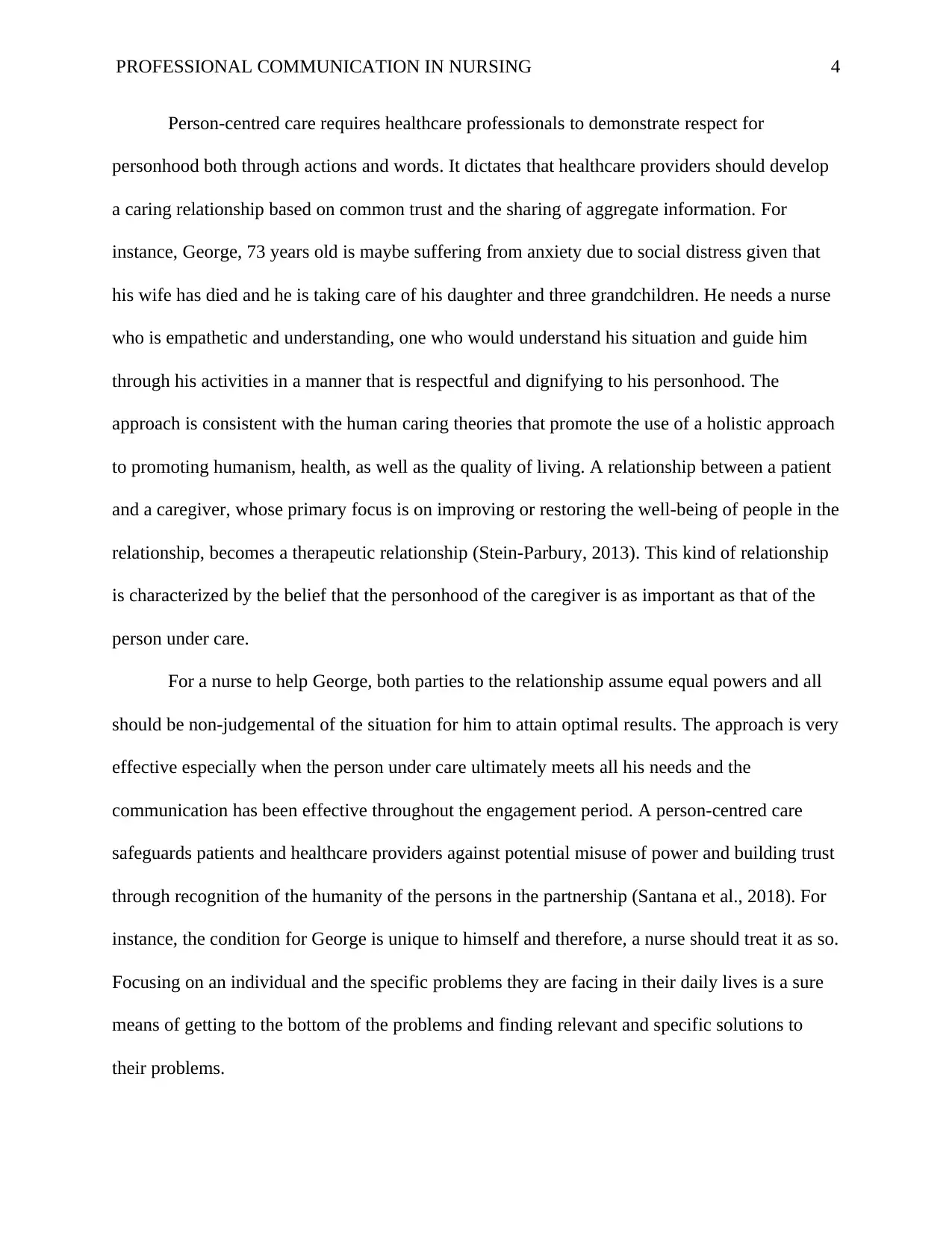
PROFESSIONAL COMMUNICATION IN NURSING 4
Person-centred care requires healthcare professionals to demonstrate respect for
personhood both through actions and words. It dictates that healthcare providers should develop
a caring relationship based on common trust and the sharing of aggregate information. For
instance, George, 73 years old is maybe suffering from anxiety due to social distress given that
his wife has died and he is taking care of his daughter and three grandchildren. He needs a nurse
who is empathetic and understanding, one who would understand his situation and guide him
through his activities in a manner that is respectful and dignifying to his personhood. The
approach is consistent with the human caring theories that promote the use of a holistic approach
to promoting humanism, health, as well as the quality of living. A relationship between a patient
and a caregiver, whose primary focus is on improving or restoring the well-being of people in the
relationship, becomes a therapeutic relationship (Stein-Parbury, 2013). This kind of relationship
is characterized by the belief that the personhood of the caregiver is as important as that of the
person under care.
For a nurse to help George, both parties to the relationship assume equal powers and all
should be non-judgemental of the situation for him to attain optimal results. The approach is very
effective especially when the person under care ultimately meets all his needs and the
communication has been effective throughout the engagement period. A person-centred care
safeguards patients and healthcare providers against potential misuse of power and building trust
through recognition of the humanity of the persons in the partnership (Santana et al., 2018). For
instance, the condition for George is unique to himself and therefore, a nurse should treat it as so.
Focusing on an individual and the specific problems they are facing in their daily lives is a sure
means of getting to the bottom of the problems and finding relevant and specific solutions to
their problems.
Person-centred care requires healthcare professionals to demonstrate respect for
personhood both through actions and words. It dictates that healthcare providers should develop
a caring relationship based on common trust and the sharing of aggregate information. For
instance, George, 73 years old is maybe suffering from anxiety due to social distress given that
his wife has died and he is taking care of his daughter and three grandchildren. He needs a nurse
who is empathetic and understanding, one who would understand his situation and guide him
through his activities in a manner that is respectful and dignifying to his personhood. The
approach is consistent with the human caring theories that promote the use of a holistic approach
to promoting humanism, health, as well as the quality of living. A relationship between a patient
and a caregiver, whose primary focus is on improving or restoring the well-being of people in the
relationship, becomes a therapeutic relationship (Stein-Parbury, 2013). This kind of relationship
is characterized by the belief that the personhood of the caregiver is as important as that of the
person under care.
For a nurse to help George, both parties to the relationship assume equal powers and all
should be non-judgemental of the situation for him to attain optimal results. The approach is very
effective especially when the person under care ultimately meets all his needs and the
communication has been effective throughout the engagement period. A person-centred care
safeguards patients and healthcare providers against potential misuse of power and building trust
through recognition of the humanity of the persons in the partnership (Santana et al., 2018). For
instance, the condition for George is unique to himself and therefore, a nurse should treat it as so.
Focusing on an individual and the specific problems they are facing in their daily lives is a sure
means of getting to the bottom of the problems and finding relevant and specific solutions to
their problems.
Paraphrase This Document
Need a fresh take? Get an instant paraphrase of this document with our AI Paraphraser
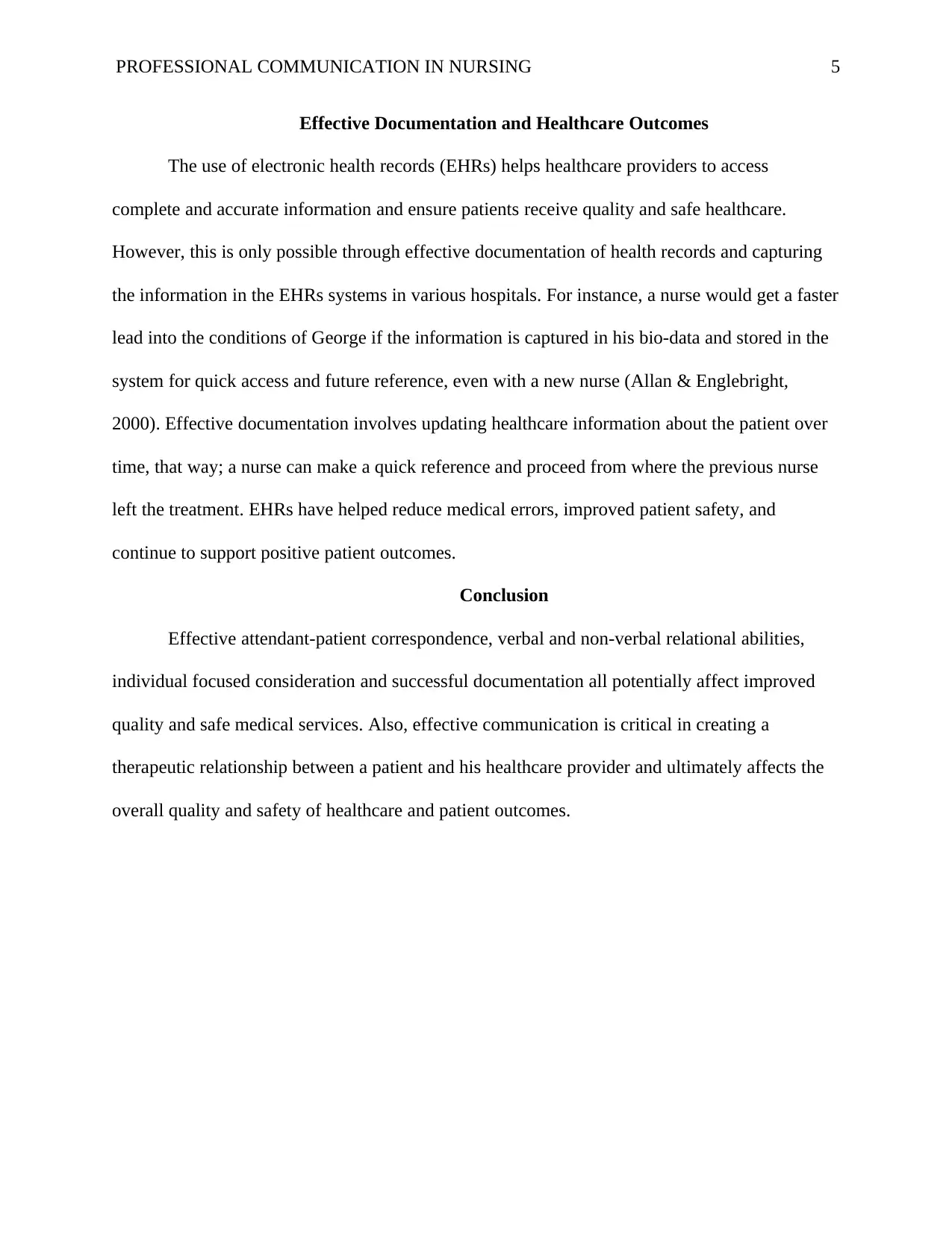
PROFESSIONAL COMMUNICATION IN NURSING 5
Effective Documentation and Healthcare Outcomes
The use of electronic health records (EHRs) helps healthcare providers to access
complete and accurate information and ensure patients receive quality and safe healthcare.
However, this is only possible through effective documentation of health records and capturing
the information in the EHRs systems in various hospitals. For instance, a nurse would get a faster
lead into the conditions of George if the information is captured in his bio-data and stored in the
system for quick access and future reference, even with a new nurse (Allan & Englebright,
2000). Effective documentation involves updating healthcare information about the patient over
time, that way; a nurse can make a quick reference and proceed from where the previous nurse
left the treatment. EHRs have helped reduce medical errors, improved patient safety, and
continue to support positive patient outcomes.
Conclusion
Effective attendant-patient correspondence, verbal and non-verbal relational abilities,
individual focused consideration and successful documentation all potentially affect improved
quality and safe medical services. Also, effective communication is critical in creating a
therapeutic relationship between a patient and his healthcare provider and ultimately affects the
overall quality and safety of healthcare and patient outcomes.
Effective Documentation and Healthcare Outcomes
The use of electronic health records (EHRs) helps healthcare providers to access
complete and accurate information and ensure patients receive quality and safe healthcare.
However, this is only possible through effective documentation of health records and capturing
the information in the EHRs systems in various hospitals. For instance, a nurse would get a faster
lead into the conditions of George if the information is captured in his bio-data and stored in the
system for quick access and future reference, even with a new nurse (Allan & Englebright,
2000). Effective documentation involves updating healthcare information about the patient over
time, that way; a nurse can make a quick reference and proceed from where the previous nurse
left the treatment. EHRs have helped reduce medical errors, improved patient safety, and
continue to support positive patient outcomes.
Conclusion
Effective attendant-patient correspondence, verbal and non-verbal relational abilities,
individual focused consideration and successful documentation all potentially affect improved
quality and safe medical services. Also, effective communication is critical in creating a
therapeutic relationship between a patient and his healthcare provider and ultimately affects the
overall quality and safety of healthcare and patient outcomes.
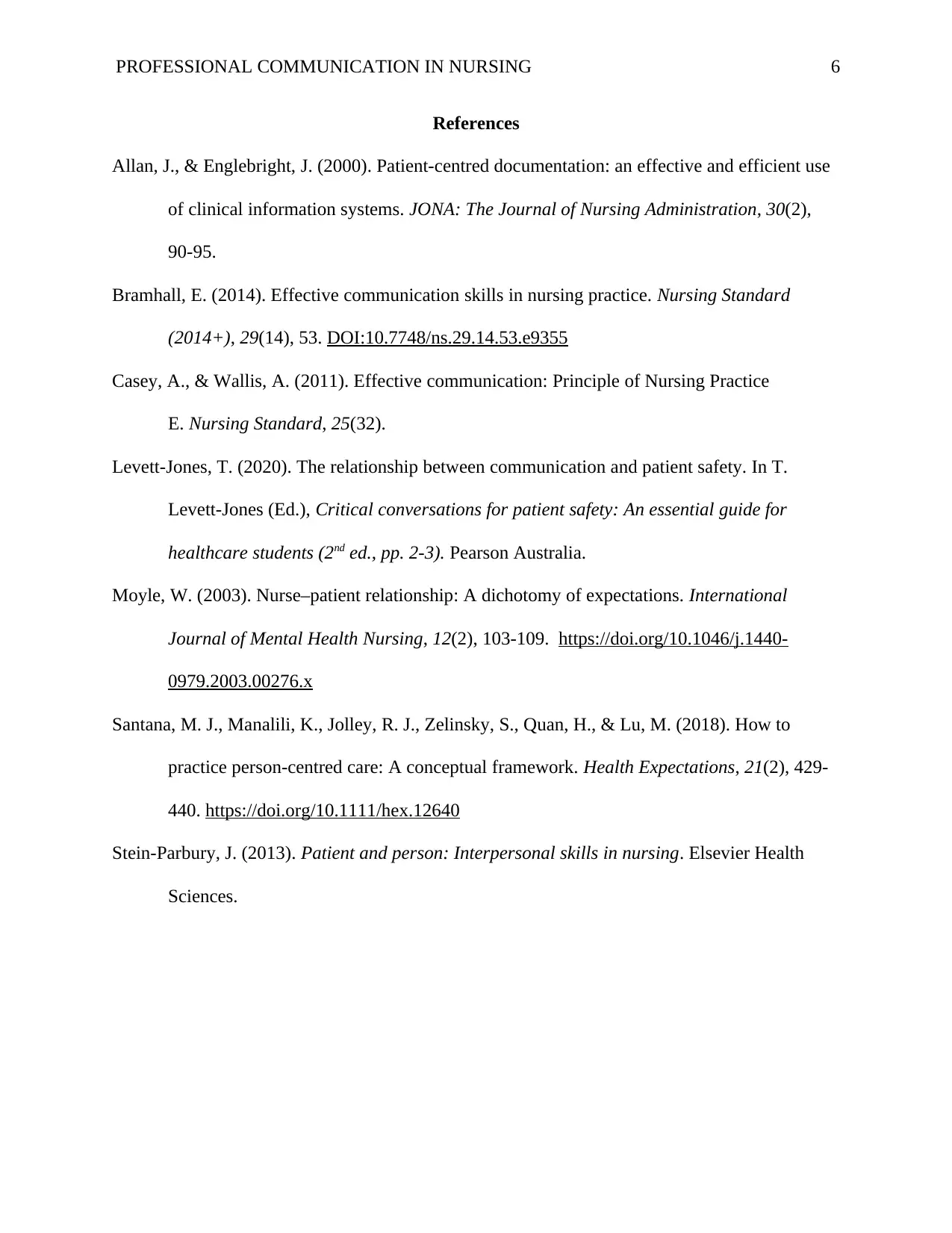
PROFESSIONAL COMMUNICATION IN NURSING 6
References
Allan, J., & Englebright, J. (2000). Patient-centred documentation: an effective and efficient use
of clinical information systems. JONA: The Journal of Nursing Administration, 30(2),
90-95.
Bramhall, E. (2014). Effective communication skills in nursing practice. Nursing Standard
(2014+), 29(14), 53. DOI:10.7748/ns.29.14.53.e9355
Casey, A., & Wallis, A. (2011). Effective communication: Principle of Nursing Practice
E. Nursing Standard, 25(32).
Levett-Jones, T. (2020). The relationship between communication and patient safety. In T.
Levett-Jones (Ed.), Critical conversations for patient safety: An essential guide for
healthcare students (2nd ed., pp. 2-3). Pearson Australia.
Moyle, W. (2003). Nurse–patient relationship: A dichotomy of expectations. International
Journal of Mental Health Nursing, 12(2), 103-109. https://doi.org/10.1046/j.1440-
0979.2003.00276.x
Santana, M. J., Manalili, K., Jolley, R. J., Zelinsky, S., Quan, H., & Lu, M. (2018). How to
practice person‐centred care: A conceptual framework. Health Expectations, 21(2), 429-
440. https://doi.org/10.1111/hex.12640
Stein-Parbury, J. (2013). Patient and person: Interpersonal skills in nursing. Elsevier Health
Sciences.
References
Allan, J., & Englebright, J. (2000). Patient-centred documentation: an effective and efficient use
of clinical information systems. JONA: The Journal of Nursing Administration, 30(2),
90-95.
Bramhall, E. (2014). Effective communication skills in nursing practice. Nursing Standard
(2014+), 29(14), 53. DOI:10.7748/ns.29.14.53.e9355
Casey, A., & Wallis, A. (2011). Effective communication: Principle of Nursing Practice
E. Nursing Standard, 25(32).
Levett-Jones, T. (2020). The relationship between communication and patient safety. In T.
Levett-Jones (Ed.), Critical conversations for patient safety: An essential guide for
healthcare students (2nd ed., pp. 2-3). Pearson Australia.
Moyle, W. (2003). Nurse–patient relationship: A dichotomy of expectations. International
Journal of Mental Health Nursing, 12(2), 103-109. https://doi.org/10.1046/j.1440-
0979.2003.00276.x
Santana, M. J., Manalili, K., Jolley, R. J., Zelinsky, S., Quan, H., & Lu, M. (2018). How to
practice person‐centred care: A conceptual framework. Health Expectations, 21(2), 429-
440. https://doi.org/10.1111/hex.12640
Stein-Parbury, J. (2013). Patient and person: Interpersonal skills in nursing. Elsevier Health
Sciences.
⊘ This is a preview!⊘
Do you want full access?
Subscribe today to unlock all pages.

Trusted by 1+ million students worldwide
1 out of 6
Related Documents
Your All-in-One AI-Powered Toolkit for Academic Success.
+13062052269
info@desklib.com
Available 24*7 on WhatsApp / Email
![[object Object]](/_next/static/media/star-bottom.7253800d.svg)
Unlock your academic potential
Copyright © 2020–2025 A2Z Services. All Rights Reserved. Developed and managed by ZUCOL.





